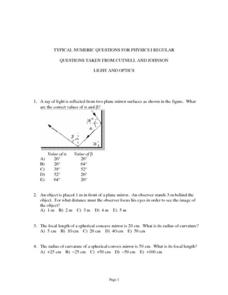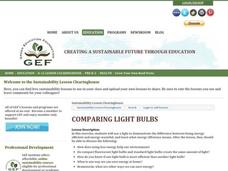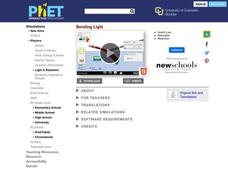Light Teacher Resources
Hi, What do you want to do?
Find Light lesson plans and worksheets
Showing 9,078 resources
Curated OER
Typical Numeric Questions for Physics I - Light and Optics
Nineteen word problems dealing with frequency, speed, reflection, and refraction of light are provided here. Empower your physics masters to manipulate equations for computing angles, focal lengths, image heights, and more! This is a...
Curated OER
Lesson 3 - Lighting Design
The final lesson in a series on theatre design spotlights how lighting is incorporated into a production. After watching videos that focus on lighting fixtures and their positioning, individuals create a basic design plan for a scene,...
Curated OER
Comparing Light Bulbs
Third graders learn how light bulbs are different and which are more cost efficient. In this energy and efficiency instructional activity, 3rd graders compare the cost of a light bulb and understand that its lifetime is important...
Curated OER
Measuring Speed of Light
A beam of laser light is sent to a satellite from a transmitter and travels 40,000 km. Elapsed time is recorded. This is all done to prove that the speed of light is 300,000 km/sec. This interesting clip can be used when you teach young...
Khan Academy
What is Inside a Tap Light?, Reverse Engineering, Electrical Engineering
Turning on a tap light requires just a tap, but breaking it apart requires a bit more work. Viewers watch as the narrator disassembles a tap light into its components. The video explains the purpose of each part and how the tap light works.
Curated OER
Light and Elements
Here is a full-fledged investigation of light waves, the electromagnetic spectrum, and element spectra. Physicists research a scientist that contributed to our understanding of the behavior of light. They take notes on your lecture, and...
Curated OER
Dependence of Light Intensity on Distance
Hopefully you have a sensor interface for your physics class to use with graphing calculators when collecting data with a light sensor. If so, read on. Use this resource for learners to predict and then test whether or not the intensity...
Curated OER
Shadows & Light, Science & Puppetry
Lights, shadows, action, and inquiry await your artistic scientists. They explore the way light travels, absorbs, reflects, and transmits through shadow play. They create folktale-inspired shadow puppets, explore the science of light,...
Curated OER
STEMbite: Polarization of Light
Here is a backyard explanation of the polarization of light. Using his porch railing, the video narrator demonstrates that if the grating is lined up with the direction of light waves, represented by a hula hoop, the waves are allowed to...
101 Questions
Speed of Light
How quickly does light travel long distances? A short video simulates light going from the earth to the moon at two different paces. Scholars relate the distance to the rate to understand which simulation is correct.
TED-Ed
How Light Technology Is Changing Medicine
Medicine has gone high tech. But how do the new, less invasive diagnostic tools work? An engaging short video sheds light on how integrated photonics is revolutionizing the medical sensor industry.
Curated OER
Color at Light Speed
Rainbow science anyone? learners put the color specturm, frequency, light waves, and wavelengths into a light speed context. They use algebraic formulas to determine the speed of each light wave length. A great way to connect math and...
Curated OER
How Light Can "Bend"
Examine the properties of light with a fifth grade science experiment. Pupils find out how light bounces off the surface of a mirror, as well as how a periscope works. For the science investigation part, kids build their own periscope...
Curated OER
On The Light Side
Kindergartners identify different sources of light in a science activity. They view pictures of a flashlight, a match, and a lamp, among others, and color the part of the picture that creates light. A science activity prompts them to...
CK-12 Foundation
Light Wave
Do radio waves create light? It's more difficult to understand the things we can't see than those that we can. The simulation compares the relatively small range of visible light to the entire electromagnetic spectrum. It graphs the size...
Cornell University
Light Waves: Grades 6-8
Explore the behavior of light with different materials. Collaborative groups determine whether certain materials absorb, reflect, diffract, or transmit light waves. They then measure the angle of incidence and angle of reflection.
Curated OER
The Northern Lights
Have any of your students seen the Northern Lights or heard of the Aurora Borealis? After reading an excerpt from the book Alaska by Rebecca Stefoff, discuss the story with your students. Next, divide your class into four groups to...
Curated OER
Amazing Northern Lights Time Lapse
Show your class exactly what the Northern Lights look like! This actual footage makes for a high-quality video, especially for an earth science class. No sound is included.
PHET
Molecules and Light
Does light affect molecules or does it go right through them? The simulation explores four different types of light: microwave, infrared, visible, and ultraviolet. Scholars alter the energy level of each as it is aimed at seven different...
PHET
Bending Light
Different colors of the spectrum travel at different speeds through media, causing them to refract at different angles—which allows humans to see their colors. Through a simulation, pupils see how air, water, and other media bend light....
Science 4 Inquiry
Trick or Science: Catching the Light
Your class might be surprised to learn that mirrors have been around since the first century AD! Young scientists explore reflection and refraction of light through a series of challenges. They use this knowledge to design their own...
Physics Classroom
Light Intensity
Light intensity varies by the strength of the light bulb as well as the distance to the light bulb. Pupils apply these concepts independently at first. They must solve for the light intensity as either the distance or the wattage of the...
Scholastic
Study Jams! Light Absorption, Reflection, & Refraction
Zoe and RJ are trying to photograph an egret on a lake, but they are having trouble with the lighting. Reflection, refraction, and absorption are explored through their thoughtful dialogue so that your physical scientists are illuminated...
Bozeman Science
Light
Colors, a variation of the wavelength of light they emit, is the focus of a video that explains the different frequencies of light waves, models how our brain processes the electromagnetic radiation, and how we perceive light.























